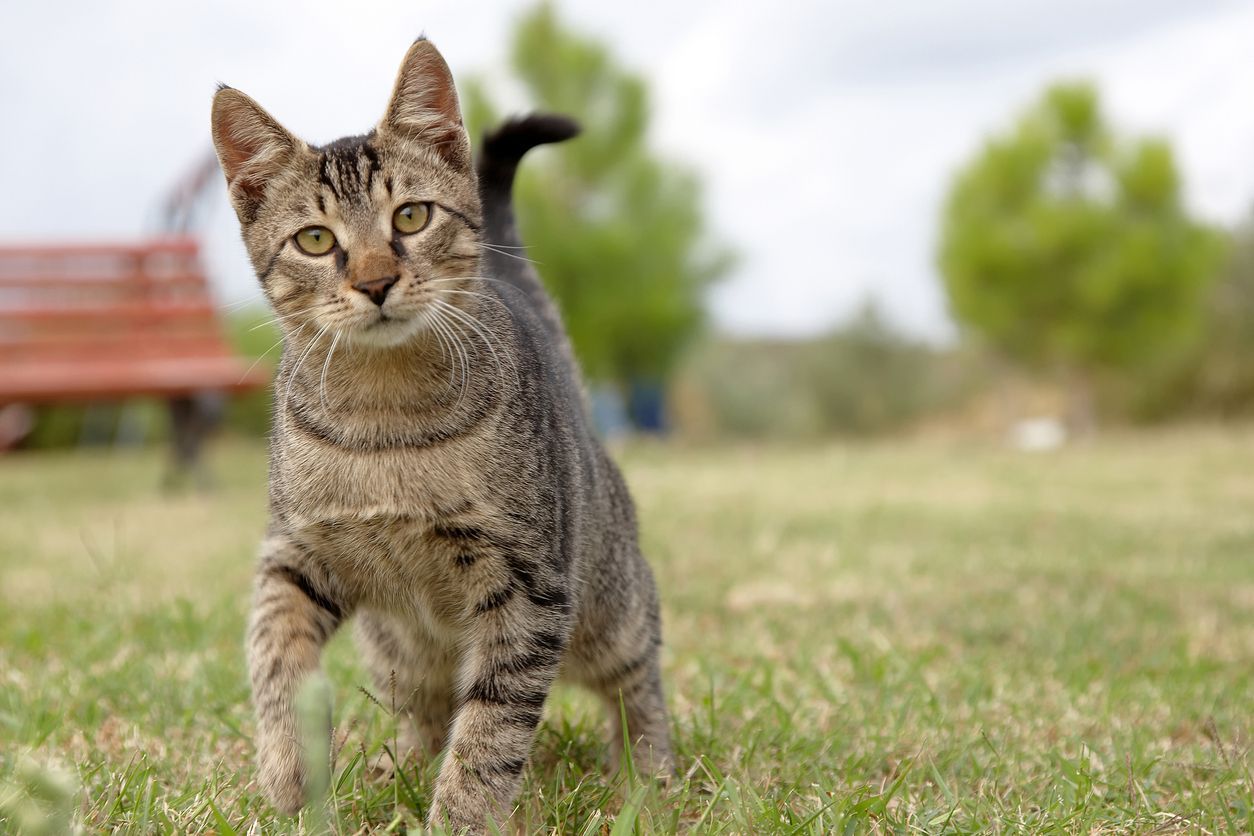How do I know if my cat has arthritis?

Disclaimer: This article, its content and related references do not constitute veterinary advice and should not be considered a substitute for veterinary care. If your pet is showing any symptoms that could indicate a medical emergency, please seek immediate emergency care.
There are different types of arthritis a cat can develop. Osteoarthritis, which occurs as the cushioning cartilage between joints wears away, is a common type of joint disease in cats, especially in seniors. Signs of arthritis are often subtle, so it’s important for cat owners to be able to recognize signs of arthritis in their feline friends and when to seek veterinary care. Read on to learn:
- The effect of osteoarthritis in cats
- The diagnostic and management process for arthritis in cats
- What to do if your cat has symptoms of joint pain
Common signs of arthritis in cats include spending less time than usual in favorite elevated places, an unkempt coat from lack of grooming, and an overall decrease in activity level. Osteoarthritis is a progressive, incurable, painful disease that’s common in cats. While it can’t be cured or reversed, an early diagnosis can help relieve pain, slow the progression of the disease, and provide a better quality of life.
What is feline arthritis?
Arthritis is inflammation of the joints. There are different types of arthritis in cats, such as:
- Osteoarthritis
- Joint infections (septic arthritis)
- Immune-mediated arthritis
- Joint inflammation caused by injury or trauma
Osteoarthritis is the most common type of arthritis in cats, especially in seniors. This type of arthritis develops as the cartilage between joint bones wears down, allowing the bones to rub against each other. This is a very painful joint disease that can affect a cat’s overall quality of life. Most senior cats have some degree of osteoarthritis.
“Osteoarthritis is an incurable and progressive disease,” explains Dr. Jo Myers, a veterinarian on Vetster. “The focus of arthritis treatment is to minimize symptoms and delay progression in order to maximize the affected cat’s quality of life.” It’s important for a cat owner to seek veterinary care when their pet has signs of joint pain or there are changes to their cat’s normal behavior. Veterinarians can make an accurate diagnosis and provide treatment. Since the symptoms of osteoarthritis are often subtle in cats, do not assume your cat is simply slowing down due to old age.
Other health conditions with similar symptoms
Other joint conditions and health issues can cause similar symptoms to arthritis. These conditions include:
- Injuries (limb fractures, dislocations, sprains, and strains)
- Knee caps that partially dislocate (luxating patellae)
- Elbow or hip dysplasia
- Bone cancer (osteosarcoma)
- Neurologic conditions that cause mobility issues
These various conditions require different treatment methods, so getting an accurate diagnosis for a cat with joint or mobility symptoms is essential.
Common symptoms of arthritis in cats
Signs of arthritis in cats can be subtle due to their tendency to hide their pain. Symptoms can vary depending on what joint is affected and how far the disease has progressed. Signs of arthritis in cats include both physical and behavioral changes.
Physical signs of osteoarthritis in cats
Physical signs of feline arthritis include:
- Stiffness
- Inability or reluctance to jump or climb
- Unkempt coat from decreased grooming
- Weight loss
- Loss of muscle on the legs, hips, and back (muscle atrophy)
- Limping
- Joint swelling
Arthritis can affect one or more legs as well as the lower back. It’s not uncommon for multiple legs to be affected at once. Signs of osteoarthritis are not typically obvious in cats. Observing to see if a cat cries out in pain when an arthritic joint is touched or moved is not a reliable method of testing for pain.
Behavioral signs of osteoarthritis in cats
Pain and discomfort can lead to changes in a cat’s normal behavior. These changes may include:
- Loss of appetite
- Urinating or defecating outside of the litter box
- No longer spending time in favorite elevated places
- Grooming less
- Hiding more
- Irritability or aggressive behaviors
One of the most common early signs of feline arthritis is a subtle reduction in activity level, such as sleeping more, playing less, and spending less time in elevated places, like cat trees. These signs may not be as obvious in senior cats, who aren’t normally very active.
How is osteoarthritis in cats diagnosed and treated?
When a cat presents with signs of joint pain, a vet usually starts with a thorough physical examination and may recommend X-rays. Additional diagnostic tests may be recommended to rule out infection and other conditions that affect the joints. Additional testing may include:
- Advanced imaging, such as CT or MRI scans
- Sampling joint fluid
- Bloodwork
- Biopsy
Osteoarthritis cannot be cured, so treatment options focus on managing symptoms and improving quality of life. Arthritis management in cats may include:
- Weight management
- Home modification
- Gentle exercise and physical therapy
- Vet-recommended joint supplements
- Surgery
Getting overweight cats with osteoarthritis to a healthy weight is one of the best things a pet parent can do to help. Excess weight puts added stress on joints. In addition to managing a cat’s weight, home modifications can help a cat day-to-day. Providing litter boxes with low sides, ramps or pet stairs to favorite spots, and ample soft, heated beds can help with their daily activities. Encouraging gentle exercise and play are also important for cats with osteoarthritis to maintain a healthy weight and muscle tone. In addition, physical therapy and gentle exercise may improve the joints’ range of motion and help relieve pain.
These management strategies are especially important because cat medication options for pain and inflammation are limited. Cats do not respond well to NSAIDs (non-steroidal anti-inflammatory drugs), which are frequently used to treat arthritis in dogs and people, but there are some feline-safe options. Talk to a veterinarian to learn what options there are for your cat.
Is there a cure for arthritis in cats?
Osteoarthritis is a progressive, degenerative disease that is irreversible and cannot be cured. Treatment focuses on slowing the disease as much as possible and providing pain management instead of curing or reversing the condition.
What to do if your cat shows signs of osteoarthritis
It’s important for pet owners to avoid assuming their cat is slowing down simply because they’re getting older. Talk to a veterinarian any time your cat shows changes in their physical health or normal behavior. Cats have a tendency to hide their pain, making signs subtle and easily overlooked. A video of any changes in gait, jumping, or climbing may be helpful to a veterinarian because many cats will freeze or not walk normally in a veterinary practice. An online vet appointment on the Vetster platform is a great way for a vet to observe your cat’s mobility and offer support and guidance on the next steps to take.
FAQ - How do I know if my cat has arthritis?
How can I tell if my cat has arthritis?
Signs of feline arthritis are often subtle, especially in the early stages of the disease. Cats with osteoarthritis may show signs such as decreased levels of activity, less time than normal spent in favorite elevated places, and an unkempt coat due to reduced grooming. It’s important to seek veterinary care when your cat shows changes in their physical condition or normal behavior so they can receive proper treatment.
At what age do cats get arthritis?
There are many types of arthritis that can affect cats of all ages. Osteoarthritis, the form of arthritis that develops due to wear and tear as a cat ages, is the most common. Most senior cats have some level of osteoarthritis. Cats are generally considered to be seniors at the age of eleven, but this varies between individuals and is based on overall health.
How does a cat with arthritis walk?
Cats with arthritis may limp or have an overall altered gait. However, a changed walk is rarely the first physical sign of reduced mobility in cats. More common signs of feline arthritis include decreased grooming, spending less time in favorite elevated spots, urinating or defecating outside of the litter box, and having an overall reduced activity level.




